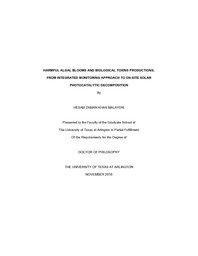
ATTENTION: The works hosted here are being migrated to a new repository that will consolidate resources, improve discoverability, and better show UTA's research impact on the global community. We will update authors as the migration progresses. Please see MavMatrix for more information.
Show simple item record
| dc.contributor.advisor | Choi, Hyeok | |
| dc.creator | Zaman Khan Malayeri, Hesam | |
| dc.date.accessioned | 2018-03-08T17:16:33Z | |
| dc.date.available | 2018-03-08T17:16:33Z | |
| dc.date.created | 2016-12 | |
| dc.date.issued | 2016-12-20 | |
| dc.date.submitted | December 2016 | |
| dc.identifier.uri | http://hdl.handle.net/10106/27261 | |
| dc.description.abstract | Occurrence of Harmful Algal Blooms (HABs) worldwide has caused concern to environmental and health authorities because of their potential to generate and release biological toxins. In particular, microcystins (MCs) produced from cyanobacteria are of great concern. MCs are among the most powerful natural poisons. The presence of MCs in drinking water sources has raised major concern.
The overall goal of this research is to predict formation of biological toxins in water bodies and to develop a new sustainable approach to decompose them, if feasible, on-site and in real-time with minimal efforts, less chemicals, and low energy inputs.
In order to achieve the goal, the first objective was to predict MC-LR formation during harmful algal blooms utilizing easy-to-detect indirect parameters. There have been efforts to monitor HAB activities and toxin releases, including i) manual field sampling followed by in lab analysis to directly measure MCs (i.e., biological toxins), ii) remote sensing based on satellite image analysis to estimate cyanobacterial index (i.e., algal blooms), and iii) in situ sensing of easily measurable proxy parameters to algal blooms such as phycocyanin (an accessory pigment to chlorophyll associated with HABs). The current observation systems for monitoring HABs discussed while pointing out their advantageous and disadvantages.
Second objective was to pioneer a high efficiency visible light-activated TiO2 photocatalytic process to decompose biological toxins. For on-site applications, the TiO2 firmly immobilized onto a glass substrate in form of nanoporous thin film. Effect of operation parameters such as type of surfactants, calcination temperature, number of coatings and pH was investigated. In order to evaluate potential field application of our system, we use lake water spiked with MC-LR under solar radiation and the result showed our film has high potential to decompose biological toxins under solar radiation within a reasonable time | |
| dc.format.mimetype | application/pdf | |
| dc.language.iso | en_US | |
| dc.subject | Harmful algal blooms | |
| dc.subject | Microcystins | |
| dc.subject | Cyanobacterial index | |
| dc.subject | Monitoring and observation | |
| dc.subject | Biological toxins | |
| dc.subject | TiO2 photocatalysis | |
| dc.subject | On-site treatment | |
| dc.title | HARMFUL ALGAL BLOOMS AND BIOLOGICAL TOXINS PRODUCTIONS; FROM INTEGRATED MONITORING APPROACH TO ON-SITE SOLAR PHOTOCATALYTIC DECOMPOSITION | |
| dc.type | Thesis | |
| dc.contributor.committeeMember | Kruzic, Andrew P. | |
| dc.contributor.committeeMember | Sattler, Melanie L. | |
| dc.contributor.committeeMember | Hu, Qinhong | |
| dc.degree.department | Civil Engineering | |
| dc.degree.name | Doctor of Philosophy in Civil Engineering | |
| dc.date.updated | 2018-03-08T17:16:33Z | |
| thesis.degree.department | Civil Engineering | |
| thesis.degree.grantor | The University of Texas at Arlington | |
| thesis.degree.level | Doctoral | |
| thesis.degree.name | Doctor of Philosophy in Civil Engineering | |
| dc.type.material | text | |
Files in this item
- Name:
- ZAMANKHANMALAYERI-DISSERTATION ...
- Size:
- 1.063Mb
- Format:
- PDF
This item appears in the following Collection(s)
Show simple item record


